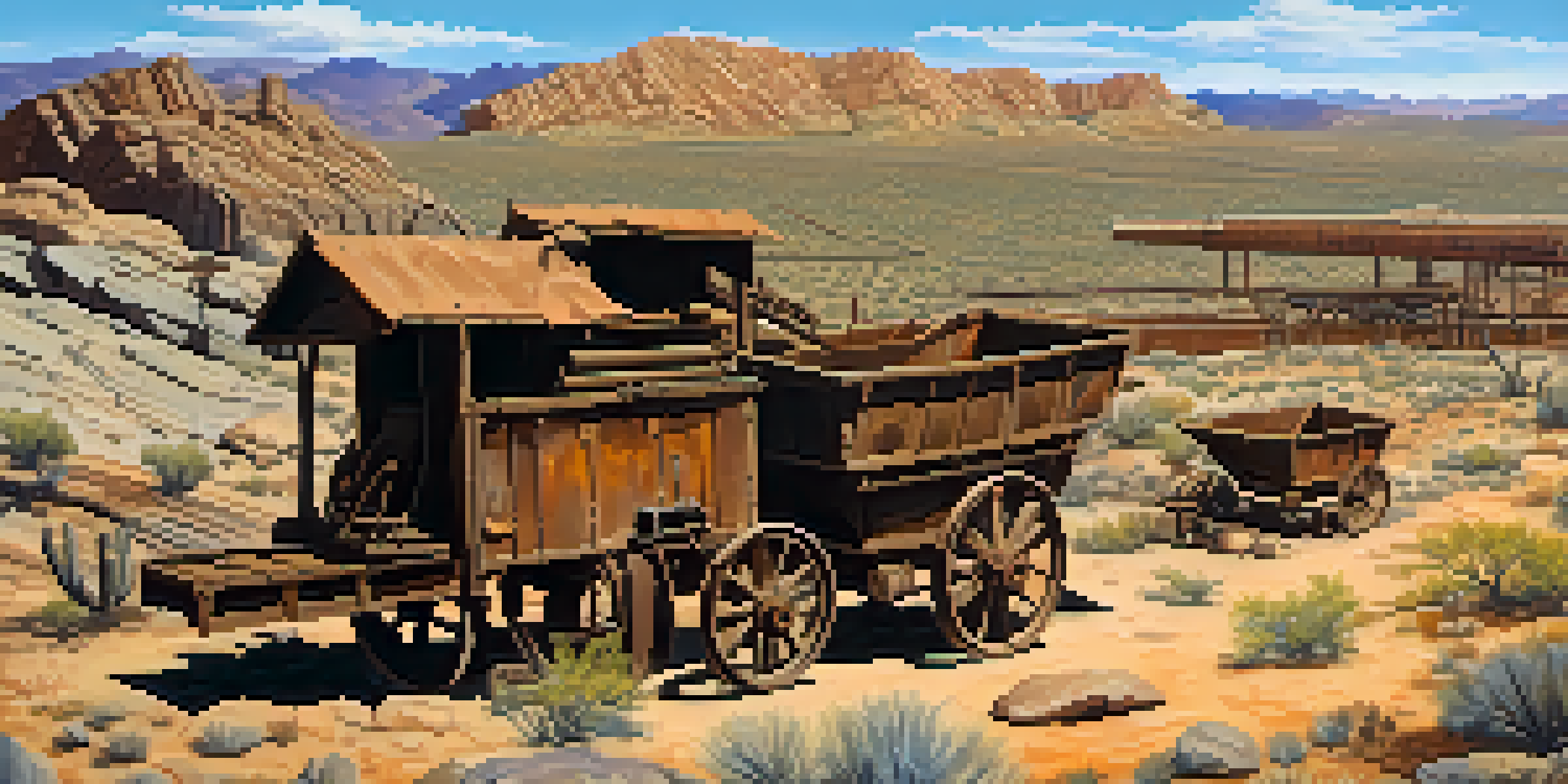Arizona's Historic Gold Mines: Tales of Wealth and Struggle

The Allure of Gold: Arizona's Mining Beginnings
Gold mining in Arizona began in the mid-19th century, drawing prospectors with dreams of wealth. The discovery of gold in places like La Paz County sparked a rush, making it a hotbed for fortune seekers. These early miners faced harsh conditions, but the lure of gold kept them pushing forward.
Gold is a treasure, and he who possesses it does all he wishes to do in this world.
As they scoured the land, many faced challenges such as scarce resources and dangerous weather. However, the promise of riches often outweighed the risks, leading to a boom in mining towns. The excitement of finding gold created a vibrant culture, with stories of both triumph and tragedy emerging.
The initial successes laid the groundwork for larger operations, attracting investors and further miners. Such endeavors paved the way for the establishment of several significant mines that would later define Arizona's mining legacy.
Major Gold Mines: The Titans of the Industry
Among the most notable mines in Arizona is the Gold Road Mine, which operated from the late 1800s to the 1940s. This mine produced thousands of ounces of gold, significantly contributing to the local economy. Its operations transformed the area into a bustling community filled with miners and their families.

Another significant site is the Vulture Mine, which saw its peak during the 1860s. The mine not only yielded gold but also silver, making it a dual treasure trove. Its rich history includes tales of hard work and the sometimes perilous conditions miners faced underground.
Gold Mining's Impact on Arizona
Gold mining in Arizona sparked economic growth and cultural development, shaping the region's identity.
These major mines reflect the industrial heart of Arizona’s mining history. They attracted a diverse group of people, creating a melting pot of cultures eager to share in the riches of the land.
Life in Mining Towns: Community and Hardship
Life in Arizona's mining towns was a mix of community spirit and tough realities. As miners flocked to these areas, they built homes, schools, and churches, hoping to create a stable life amidst the uncertainty. The camaraderie formed among miners and their families was essential for survival.
Hard work is the key to unlocking the door of success.
However, the realities were often harsh. Many miners faced dangerous working conditions, with accidents and injuries being common. The struggle for safety and fair wages led to labor disputes, shaping the labor movements in Arizona.
Despite these challenges, the sense of community prevailed. Festivals, gatherings, and shared hardships brought residents together, creating a bond that would last through the years, even as the gold ran out.
The Struggle for Safety: Miners' Rights and Labor Movements
As mining operations expanded, so did the need for improved working conditions. Miners began to organize, pushing for safer practices and fair wages. They recognized that their collective voice could bring about change in an industry often characterized by exploitation.
Strikes and protests became common as miners sought better treatment. These movements were not without risk, often leading to confrontations with mine owners and law enforcement. Yet, their determination to fight for their rights laid the groundwork for future labor reforms.
Community and Struggles in Mining Towns
Life in mining towns was marked by a strong sense of community, despite the harsh realities and labor struggles faced by miners.
The legacy of these struggles is still felt today, as labor rights continue to evolve. The courage displayed by these early miners inspired later generations to advocate for better working conditions across various industries.
Environmental Impact: Gold Mining's Legacy
While gold mining brought wealth to Arizona, it also left a complex environmental legacy. The extraction process often led to deforestation, water pollution, and habitat destruction. Many communities are still grappling with the long-term effects of mining activities on their landscapes.
Efforts to mitigate these impacts have been ongoing, with regulations aimed at protecting the environment. Modern mining practices strive to balance resource extraction with ecological responsibility. However, the scars of past mining activities remain visible in many areas.
As Arizona continues to evolve, the conversation around sustainable practices grows more critical. It’s a reminder of the importance of considering both economic gain and environmental stewardship in resource management.
Touring Arizona's Historic Gold Mines Today
Today, many of Arizona's historic gold mines have transformed into tourist attractions. Visitors can explore the remnants of these once-bustling sites, learning about the history and stories of the miners who worked there. Guided tours often include tales of hardships and successes that shaped the region.
These tours not only educate but also celebrate Arizona's rich mining heritage. They offer a glimpse into the past, allowing guests to appreciate the challenges faced by those who sought fortune beneath the earth. Engaging exhibits and artifacts provide a tangible connection to this colorful history.
Environmental Concerns of Mining
While gold mining brought wealth, it also left a complex environmental legacy that Arizona continues to address today.
For many, visiting these sites is a way to honor the legacy of the miners while enjoying the stunning landscapes of Arizona. It's a unique blend of history, adventure, and respect for the sacrifices made in the pursuit of gold.
The Enduring Legacy of Arizona's Gold Mining Era
The legacy of Arizona's gold mining era continues to influence the state today. The stories of wealth and struggle are woven into the fabric of Arizona's identity, shaping its communities and economy. Many towns built around mining have evolved, but their history remains a vital part of local culture.
As new generations learn about this history, they gain insight into the challenges and triumphs of those who came before them. The tales of resilience and determination serve as powerful reminders of the human spirit. They also highlight the importance of learning from the past to navigate the future.

Ultimately, Arizona's gold mines symbolize more than just wealth; they represent the relentless pursuit of dreams and the bonds forged through shared struggles. These stories will continue to resonate as long as there are voices willing to tell them.